October 31st, 2025
Chimney Story.
Chimney Story.
Security compliance isn’t simple. Between SOC 2 reports, ISO 27001 audits, and GDPR requirements, even organized teams can end up with scattered evidence and unclear ownership. While I don’t manage security compliance firsthand, I’ve analyzed how real professionals tackle these challenges through G2 Data and verified user reviews.
![]()
![]()
![]()
Starting a midwifery practice is exciting—but before you welcome your first clients, you need to make a critical business decision: choosing the right legal structure. Your choice affects taxes, liability, paperwork, and long-term growth potential.
At Midwifery Business Consultation, we help midwives navigate the complexities of business setup so you can focus on what matters most: providing safe, compassionate care. Here’s a detailed guide to the most common business structures for midwives: Sole Proprietor, LLC, and S-Corporation.
Your business structure impacts:
Liability protection: How your personal assets are shielded from business debt or lawsuits.
Taxes: The way income is reported and taxed can vary significantly.
Administrative requirements: Paperwork, annual filings, and compliance obligations.
Growth potential: Ability to hire employees, bring in partners, or attract investors.
Choosing the wrong structure can be costly, so it’s important to understand your options.
Overview: The simplest and most common structure for solo midwives just starting out.
Pros:
Easy to set up with minimal paperwork.
All income flows directly to your personal tax return (Schedule C).
Full control of business decisions.
Cons:
No liability protection—personal assets are at risk if your practice faces a lawsuit or debt.
Harder to scale or bring in partners.
May appear less “professional” to insurance companies and potential clients.




Overview: An LLC provides liability protection while allowing flexible management and taxation.
Pros:
Protects personal assets from business liabilities.
Flexible tax options: default pass-through taxation or elect S-Corp status later.
Easier to establish credibility with insurance companies and clients.
Less formal than a corporation (fewer meetings, less paperwork).
Cons:
Annual state filings and fees.
Some states impose additional taxes (franchise taxes, etc.).
May require more bookkeeping than a sole proprietorship.




Overview: An S-Corp is a tax designation (not a business type) that can be applied to LLCs or corporations to reduce self-employment taxes.
Pros:
Can save money on self-employment taxes by splitting owner salary and profit distributions.
Liability protection (if structured as an LLC or corporation).
Helps attract investors or partners if the practice grows.
Cons:
More administrative requirements: payroll setup, regular filings, and stricter IRS rules.
Owner must pay themselves a “reasonable salary,” which requires careful accounting.
Less flexible than a standard LLC in management structure.




Ask yourself these questions:
What level of liability protection do I need?
Solo home-birth midwives may start as an LLC.
Practices with multiple providers or higher risk may benefit from an S-Corp.
How much complexity can I manage?
Sole proprietorships are simplest, S-Corps are more complex.
What are my financial goals?
Consider taxes, reinvestment, and growth.
Will I accept insurance or hire staff?
LLC or S-Corp structures are usually more credible and easier to credential.
At Midwifery Business Consultation, we guide midwives through every step of business formation:
Compare LLC, S-Corp, and sole proprietorship options.
Help you understand liability, tax implications, and long-term growth.
Connect you with accountants and legal professionals experienced in midwifery.
Provide checklists and templates for setup, insurance credentialing, and compliance.
We’ve helped midwives nationwide choose the right structure so they can confidently launch, grow, and protect their practices.
Your business structure sets the foundation for your midwifery practice. By understanding your options and planning strategically, you protect yourself, optimize taxes, and position your practice for long-term success.
Schedule a consultation with Midwifery Business Consultation today to get personalized guidance on forming an LLC, S-Corp, or sole proprietorship that aligns with your goals and protects your future.
The post Choosing the Right Business Structure: LLC, S-Corp, or Sole Proprietor for Midwives appeared first on MIDWIFERY BUSINESS CONSULTATION.
Security compliance isn’t simple. Between SOC 2 reports, ISO 27001 audits, and GDPR requirements, even organized teams can end up with scattered evidence and unclear ownership. While I don’t manage security compliance firsthand, I’ve analyzed how real professionals tackle these challenges through G2 Data and verified user reviews.
![]()
![]()
![]()
The first things humans invented, before fire, the wheel or baked brie, was trust.
Trusting the others in the village. Trusting that you could get a good night’s sleep. Trusting that what you heard was true.
We’ve expanded the village from twenty people to billions. Walter Cronkite was effective because millions of people trusted him, and he earned that trust. And as the media became more powerful and fragmented, that contract begin to erode.
We’ve created methods of exchange and interaction that were unimaginable just a generation ago.
And, at the same time that we’ve expanded our circles of trust, we’ve pushed to make many of them digital.
Interactions by email and zoom. Documents that are written and certified by unseen intermediaries. Stories and images that feel real and local, but might be neither one.
This only works because we’ve applied our same 20-person trust instincts to each of these interactions, billions of times, around the world.
Aided by AI, the thieves and scammers are now relentlessly working to hack this basic human instinct. They’re stealing more than money.
That email might not be from the person you think it’s from. And that online recruiter, or the text you just got–it might not be worthy of the benefit of the doubt. Even phone calls from people who aren’t who they say they are–AI bots with familiar voices and plenty of specific knowledge.
Like all things amplified by computer chips and the network, this one is going to accelerate–very quickly.
People are going to be deceived, victimized and ripped off. And the sort of intimacy that marketers and institutions counted on will erode fairly quickly.
Halloween is here, and it’s not just little kids who are wearing costumes. If someone in a clown mask walks into a bank, the tellers know something’s up… trust is the first thing to go.
The short-term response is to change our bias about digital interactions–when in doubt, be more human. When in doubt, take your time. When in doubt, ask someone else to double check.
In the long run, I think we’re going to see our circles of trust shrinking. That’s sad, it’s going to fracture networks we’ve been counting on for a long time and it’s going to be confusing since the defaults will be shifting.
Marketers will discover the costs of this, but it’s individuals that will have to rebuild what they think of as community.
Watch out for tricks. All year round.
The post What’s the Best Advertising Platform for Publishers? appeared first on Ultraise.
OpenAI’s made ChatGPT Go available in 98 countries, including 8 in Europe and 5 in Latin America.
The post Discounted ChatGPT Go Is Now Available In 98 Countries appeared first on Search Engine Journal.
The U.S. roofing market hit $23.35 billion in 2024, and competition is fiercer than ever. With over 96,000 roofing contractors registered nationwide, you’re not just competing with the shop down the street anymore.
While 79% of homeowners still find roofers through word-of-mouth, 62% also go online. And here’s the game-changer: many of those searches now happen through AI tools like ChatGPT and Google’s AI Overviews before homeowners ever see a traditional search result.
Search interest in “roofing companies” grew 107% year-over-year. The roofing business has always been built on trust and reputation. What’s changed is how potential customers find you and decide whether to call.
This guide breaks down the marketing strategies that work for roofing companies in 2025. No theory, just the tactics that help you get found and hired.
72% of roofing contractors expect sales growth in 2025, but hoping for growth and planning for it are two different things. Marketing is about making sure you’re visible when a homeowner’s roof starts leaking or when they’re ready to replace those 20-year-old shingles.
67% of homeowners say online reviews are extremely or very important in their purchasing decision. That means your reputation online matters just as much as the quality of your work. Maybe more, because prospects check your reviews before they ever meet you. When you look for a roofer in your area, reputation signals like ratings and reviews are front and center in the SERP.
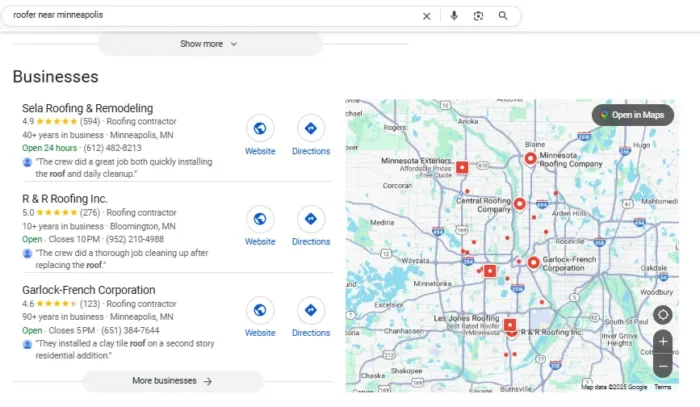

Marketing also keeps your pipeline full during slow seasons. Storm damage creates spikes in demand, but you need a steady flow of leads year-round to keep crews working and revenue stable. Without marketing, you’re reactive. With it, you’re in control.
The roofing companies that invest in marketing don’t just survive. They grow, scale, and dominate their local markets. The ones that don’t? They’re competing on price alone, and that’s a race to the bottom nobody wins.
Roofing sits at an unusual intersection in home services. Half your leads need you right now because of storm damage or leaks. The other half are planning six months out, researching materials and comparing quotes.
Most roofing demand comes from re-roofing, with the median U.S. home age nearing 40 years. That creates a predictable replacement cycle, but it also means homeowners treat roofing as a major investment. They’re not impulse buying. They’re checking multiple contractors, reading dozens of reviews, and asking neighbors who they used.
Trust matters more in roofing than almost any trade. You’re asking homeowners to spend $15,000 to $30,000 or even more on something they can’t see once it’s installed.
The buying cycle also varies wildly. Emergency repairs convert in hours. Full replacements take weeks or months of consideration. Your marketing needs to serve both audiences without confusing either one.
The tactics below aren’t theory. They’re what actually works for roofing companies competing in local markets right now.
Each strategy addresses a specific part of the customer journey. LLM marketing and SEO capture homeowners in research mode. Paid ads grab emergency leads when speed matters. Social media and content build trust over time. Email nurtures prospects who aren’t ready to buy today. Reputation management turns past customers into your best salespeople.
You don’t need to master all of these on day one. Start with the channels where your best customers are already looking, then expand as you see results.
SEO puts your roofing company in front of homeowners during their research phase, weeks or months before they’re ready to get quotes. 76% of people who search on their smartphones for something nearby visit a business within a day, making local SEO critical for roofing contractors competing in specific service areas. Businesses that appear in the Google 3-pack see a 34% higher click-through rate compared to other organic results.
Here’s what drives SEO results for roofing companies:


Social media isn’t optional for roofing companies anymore. Social media content now ranks prominently in Google search results, meaning your Facebook posts and YouTube videos can appear when homeowners search for roofing services. 89% of consumers will buy from a brand after following it on social media.
Some roofing companies might avoid social media because they don’t want to be on camera or don’t know what to post. But social media isn’t about you. It’s about showing homeowners what to expect and staying top of mind when their roof needs work.
Here’s how roofing companies should use social media:
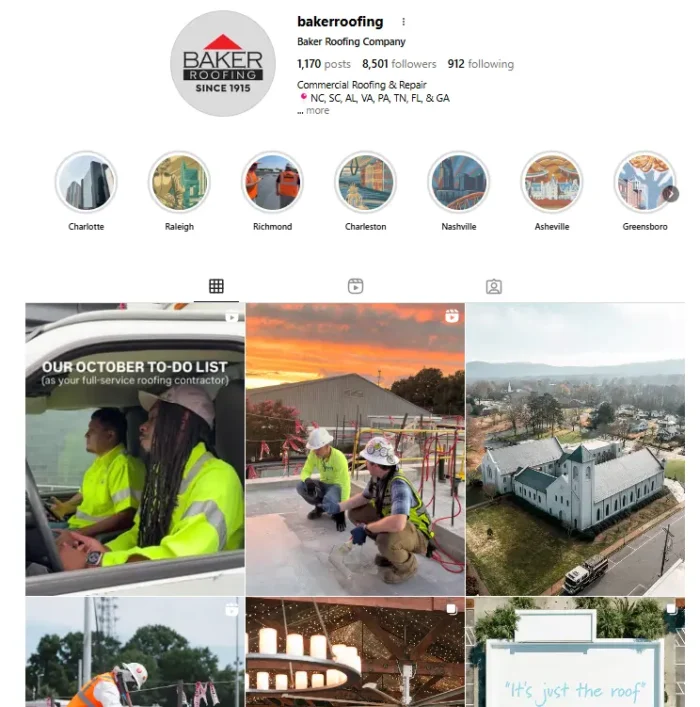

Homeowners research roofing projects for months before hiring a contractor. Content marketing puts your company in front of them during that research phase, building trust before they’re ready to get quotes.
Content works differently for roofing than other industries. It’s not about entertainment. You’re educating homeowners who need to make a major financial decision about something they don’t understand. Most people replace a roof once or twice in their lifetime. They don’t know what questions to ask.
Here’s what roofing content should cover:
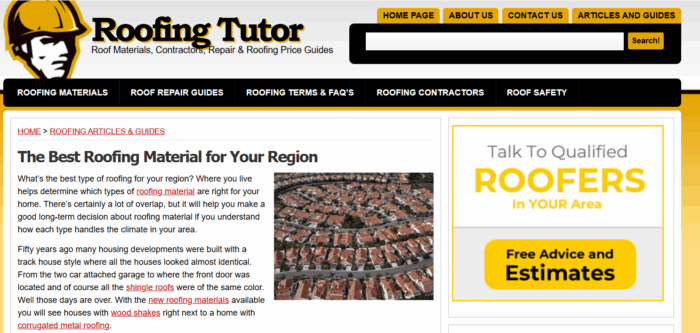

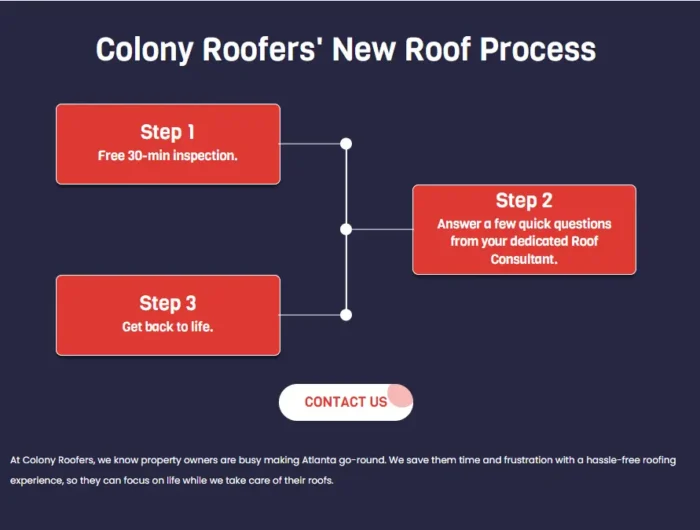

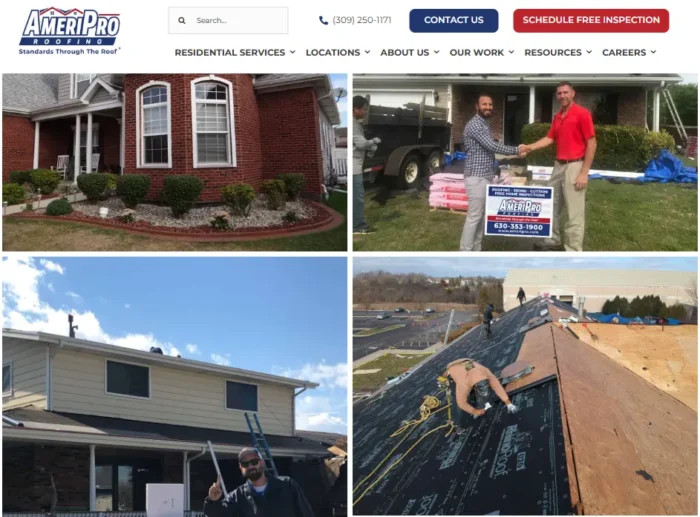

Paid ads put your roofing company in front of homeowners at the exact moment they need help. When someone searches “roof repair near me” at 8 AM after a night of heavy rain, that’s not casual browsing. That’s intent. PPC advertising captures those high-intent leads before they call your competitors.
For roofing and gutters, the average cost per click can be expensive compared to other home services, but the payoff justifies the cost. Well-optimized campaigns can bring in up to $8 for every $1 spent, especially during storm season when demand spikes.
Here’s how to make paid ads work for roofing:
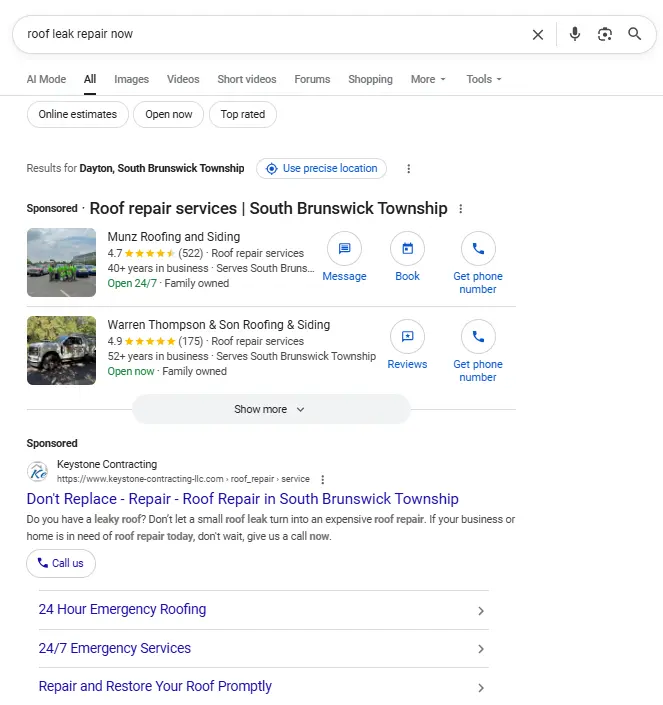

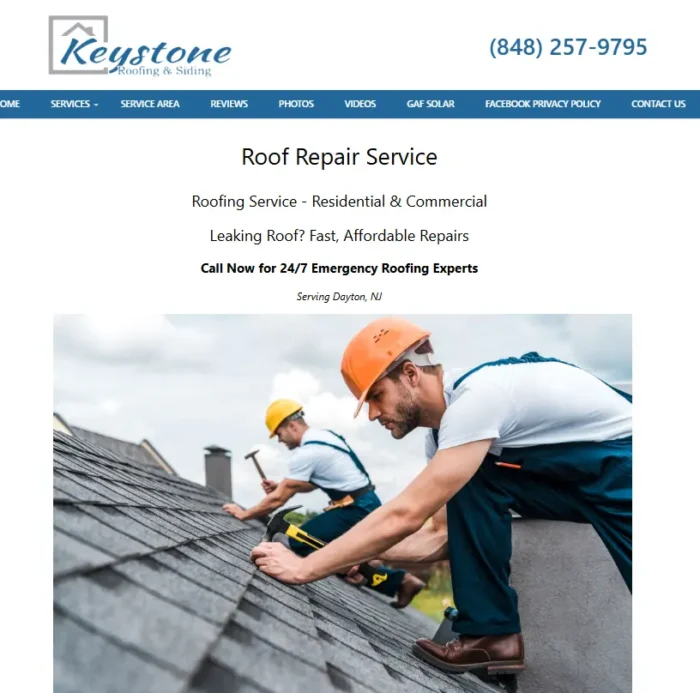

AI SEO for roofers helps roofing companies appear in answers from large language models like those that power ChatGPT, Perplexity, and Google’s AI Overviews. When a homeowner asks “What should I do about a roof leak?” or “How much does a roof replacement cost?” they’re not always clicking through to websites anymore. They’re getting answers directly from AI.
Market projections suggest that LLMs will capture 15% of the search market by 2028. That’s not replacing Google, but it’s changing how homeowners research roofing services before they ever pick up the phone.
When homeowners search for roofing services, AI-generated overviews now often appear before traditional search results, answering questions with cited sources. Getting your roofing company included in those citations means more visibility even when prospects don’t click through to your site.
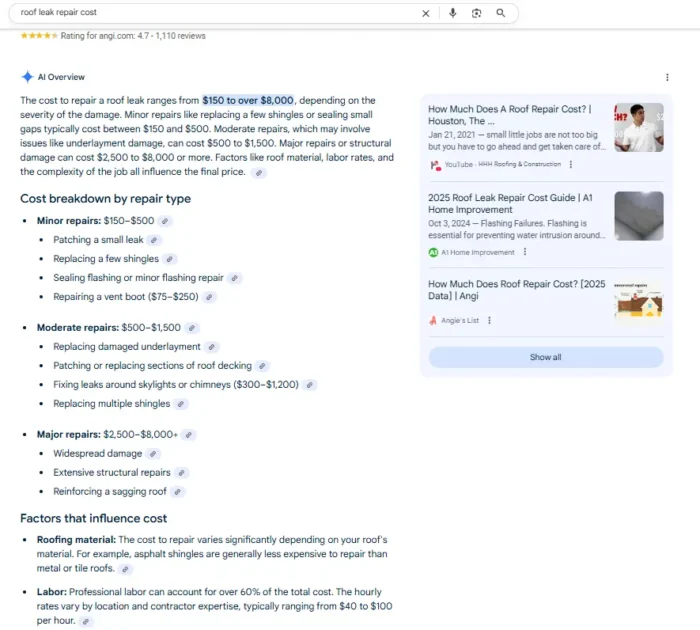

Here’s what works for roofing companies optimizing for AI search:
Most roofing jobs don’t happen immediately. Homeowners research for months before getting quotes, then take more time comparing contractors. Email keeps your company in front of prospects during that entire decision-making process without requiring constant manual follow-up.
Email marketing is one of the highest ROI channels for roofing companies. Unlike social media where algorithms control visibility, email lands directly in the inbox of people who actually want to hear from you.
Here’s how to use email marketing for roofing:
Your reputation online directly impacts whether prospects call you or your competitor, especially when considering high-stakes decisions like roofing. Reputation management for roofing companies means actively controlling what homeowners see when they research your business. One bad review on the first page of Google can cost you thousands in lost jobs.
Here’s how to manage your roofing reputation:


You can’t improve what you don’t measure. Marketing without tracking is just hoping things work. What you are looking to focus on may vary based on short-term and long-term goals.
Track these metrics to understand what’s actually driving results:
Use Google Analytics, call tracking software, and your CRM to monitor these metrics monthly. Set up dashboards showing performance by channel so you can cut what doesn’t work and double down on what does.
Start with local SEO and Google Business Profile optimization since most homeowners search for roofers nearby. Get reviews systematically after every job. Run Google Ads targeting emergency repair keywords and service-specific terms in your area. Post project photos and educational content on social media. Build an email list to nurture leads who aren’t ready to book immediately. Track which channels produce the best leads and focus your budget there.
Roofing marketing is the process of attracting homeowners who need roof repairs, replacements, or inspections and converting them into paying customers. It combines local SEO, paid advertising, content creation, social media, email marketing, and reputation management to capture leads at different stages of the buying cycle. Effective roofing marketing addresses both emergency repair needs and planned replacement projects with different strategies for each.
Roofing marketing isn’t about choosing one tactic and hoping it works. It’s about building a system that captures homeowners at every stage, from the first Google search to the follow-up email six months later.
Start with what matters most for roofing: local visibility. Optimize your Google Business Profile, get reviews, and make sure you show up when homeowners search for help. Layer in paid ads for emergency leads and content for long-term trust building.
The roofing companies winning in 2025 aren’t the ones with the biggest trucks. They’re the ones who show up first online, prove they’re trustworthy before the phone rings, and stay in touch until homeowners are ready to buy.
Need help building a complete marketing strategy? My marketing consulting services can help you dominate your local market.